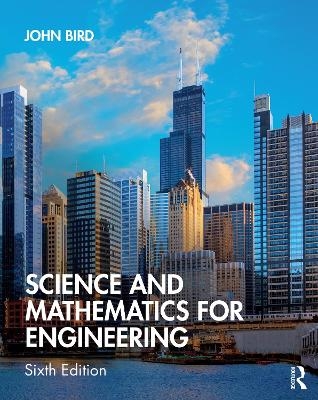
Science and Mathematics for Engineering
Routledge (Verlag)
978-0-367-20474-7 (ISBN)
A practical introduction to the engineering science and mathematics required for engineering study and practice.
Science and Mathematics for Engineering is an introductory textbook that assumes no prior background in engineering. This new edition covers the fundamental scientific knowledge that all trainee engineers must acquire in order to pass their examinations and has been brought fully in line with the compulsory science and mathematics units in the new engineering course specifications. A new chapter covers present and future ways of generating electricity, an important topic.
John Bird focuses upon engineering examples, enabling students to develop a sound understanding of engineering systems in terms of the basic laws and principles. This book includes over 580 worked examples, 1300 further problems, 425 multiple choice questions (with answers), and contains sections covering the mathematics that students will require within their engineering studies, mechanical applications, electrical applications and engineering systems.
This book is supported by a companion website of materials that can be found at www.routledge/cw/bird. This resource includes fully worked solutions of all the further problems for students to access, and the full solutions and marking schemes for the revision tests found within the book for instructor use. In addition, all 447 illustrations will be available for downloading by lecturers.
John Bird is the former Head of Applied Electronics in the Faculty of Technology at Highbury College, Portsmouth, U.K. More recently, he has combined freelance lecturing at the University of Portsmouth, with Examiner responsibilities for Advanced Mathematics with City and Guilds and examining for the International Baccalaureate Organisation. He is the author of over 130 textbooks on engineering and mathematical subjects with worldwide sales of over one million copies. He is a chartered engineer, a chartered mathematician, a chartered scientist and a Fellow of three professional institutions and is currently lecturing at the Defence School of Marine Engineering in the Defence College of Technical Training at H.M.S. Sultan, Gosport, Hampshire, U.K, one of the largest technical training establishments in Europe.
Preface. SECTION I APPLIED MATHEMATICS. 1. Basic arithmetic. 2. Fractions, decimals and percentages. 3. Indices, units, prefixes and engineering notation. 4. Calculations and evaluation of formulae. 5. Basic algebra. 6. Solving simple equations. 7. Transposing formulae. 8. Solving simultaneous equations. 9. Straight line graphs. 10. Introduction to trigonometry. 11. Area of common shapes. 12. The circle. 13. Volumes of common solids. SECTION II MECHANICAL APPLICATIONS. 14. SI units and density. 15. Atomic structure of matter. 16. Speed and velocity. 17. Acceleration. 18. Force, mass and acceleration. 19. Forces acting at a point. 20. Work, energy and power. 21. Simply supported beams. 22. Linear and angular motion. 23. Friction. 24. Simple machines. 25. The effects of forces on materials. 26. Linear momentum and impulse. 27. Torque. 28. Pressure in fluids. 29. Heat energy and transfer. 30. Thermal expansion. 31. Ideal gas laws. 32. The measurement of temperature. Revision Test 12: Thermal expansion, ideal gas laws and temperature measurement. SECTION III ELECTRICAL APPLICATIONS. 33. An introduction to electric circuits. 34. Resistance variation. 35. Batteries and alternative sources of energy. 36. Series and parallel networks. 37. Kirchhoff’s laws. 38. Magnetism and electromagnetism. 39. Electromagnetic induction. 40. Alternating voltages and currents. 41. Capacitors and inductors. 42. Electrical measuring instruments and measurements. 43. Ways of generating electricity – the present and the future. SECTION IV ENGINEERING SYSTEMS. 44. Introduction to engineering systems. List of formulae for science and engineering. Answers to Practice Exercises. Glossary of terms. Index.
| Erscheinungsdatum | 14.10.2019 |
|---|---|
| Zusatzinfo | 8 Tables, color; 447 Line drawings, black and white; 42 Halftones, black and white; 489 Illustrations, black and white |
| Verlagsort | London |
| Sprache | englisch |
| Maße | 219 x 276 mm |
| Gewicht | 2000 g |
| Themenwelt | Mathematik / Informatik ► Mathematik ► Angewandte Mathematik |
| Technik | |
| ISBN-10 | 0-367-20474-6 / 0367204746 |
| ISBN-13 | 978-0-367-20474-7 / 9780367204747 |
| Zustand | Neuware |
| Informationen gemäß Produktsicherheitsverordnung (GPSR) | |
| Haben Sie eine Frage zum Produkt? |
aus dem Bereich


